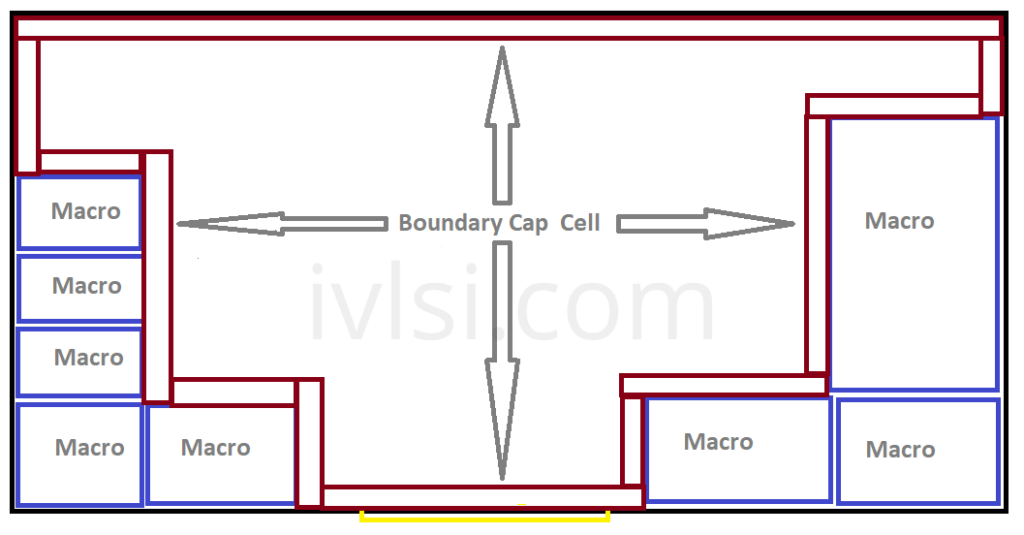In Physical design we prefer to add the spare cells using tool command. We cant have functional failure in our design.

Physical Only Cells Vlsi Physical Design For Freshers
The way of adding spare cells for Innovus and ICC tool has been explained below.

. Boundary cells does exact opposite of it. Tie cells are inserted in the placement stage and more specifically at the final stage of placement. Boundary Cap CellsEnd Cap Placement.
There are various reasons for the instant large current requirement in the circuit and if there are no adequate measures have taken to handle this requirement power. There is no logical function in well tap cell rather than proving a taping to nwell and p-substrate therefore well tap cell is called a physical-only cell. Let us continue with the physical only cells present in the standard cell libraries that ease the digital PD flow.
These are used to address boundary N-Well issues for DRC cleanup. What is Boundary Cap End Cap. End cap Cells.
These cells prevent the cell damage during fabrication. These cells are added before the placement of standard cells throughout the design. Boundary cap cells are physical only cells.
Tie cells are not present in the synthesized netlist and not placed in the initial placement of the standard cells. They connect only to the power and ground rails once power rails are created in the design. End-cap cell are physical only cells which are added to identify end of rows in digital chips or blocksThey are also added to isolate any analog IPs and digital part of any chips.
End cap cells in Physical design - Free download as PDF File pdf Text File txt or read online for free. Filler Cells Well Tap Cells Decap Cells. These do not have any logical functionality.
These cells are placed at the periphery of the core and power domain. Used for row connectivity and specifying row ending. End Caps ensure that gaps do not occur between the Well and Implant Layers and also prevents DRC violations by satisfying Well tie-off requirements for core rows.
These library cells do not have signal connectivity. So to avoid any kind of functional failure. Where ever netlist is having any pin connected to 0 logic or 1 logic like A 1b0 or IN 1b1 a tie cell gets inserted there.
It is used to isolate several designs and IPs in a SOC. They also ensure that gaps do not occur between the well and implant layers. Decap cell is basically a capacitor cell which is used temporarily in the design between power and ground rails to counter the functional failure.
We have explained all about end cap cells in this session with the he. As per SOC Encounter user guide End-cap cells are preplaced physical-only cells required to meet certain design rules placed at the ends of the site rows. Well tap cells or Tap cells are used to prevent the latch-up issue in the CMOS design.
End Cap Cells. Boundary cap cells are placed just after macro placement in the floorplan flow. It breaks the n-well in a way avoiding any DRCs.
This prevents DRC violations by satisfying well tie-off requirements for the core rows. What is Boundary Cap End Cap. These cells essentially act as a capacitance between power and ground rails and hence as a charge reservoir that can be counted upon while there is a high demand for current from the power lines.
Spare cells can be added either by the netlist or by PnR tool command or GUI too. Their layout is different from that of a filler or Dcap 2. Boundary cap cells are physical only cells.
End cap cells are also known as boundary cells. Well Taps help to tie Substrate and N-wells to VDD and VSS levels and thus. It is not possible to abut every cell available as that would cause.
What is end cap cell or Boundary cell What is the use of end cap cells in ASIC Design. The library cells do not have cell connectivity as they are only connected to power and ground rails thus to ensure that gaps do not occur between well and implant layer and to prevent the DRC violations by satisfying well tie-off requirements for core rows we use end-cap cells. Physical-Only Cells Well Taps End Caps These library cells do not have signal connectivity and connect only to the power and ground rails.
Filler Cells Once you have completed placement and routing there are usually gaps left in the layout where you do not have any standard cells present. In some technologies they serve for power distribution as well. Boundary cap cells are placed just after macro placement in the floorplan flow admin August 12 2020 Floorplan Physical Design Level Shifter Cell.
Well tap cells connect the nwell to VDD and p-substrate to VSS in order to prevent the latch-up issue. Decap Cells Decoupling capacitors are another type of physical only cells used in PD flow. To avoid drain and source short.
Placement of Spare cells. Filler type of physical only cells are used to ensure continuity between well or implant layers that would not cause design rule violations. Decap cells are basically a charge storing device made of the capacitors and used to support the instant current requirement in the power delivery network.
DeCap Cells in Physical Design Use of Decap Cells in PD. These cells are placed at the periphery of the core and power domain. A filler or Dcap cells actually helps in continuity of n-well.

Boundary Cap Cells End Cap Placement Ivlsi

Physical Only Cells Vlsi Physical Design For Freshers

Physical Only Cells Vlsi Physical Design For Freshers

Welcome To The World Of Physical Design Different Types Of Physical Cells

Team Vlsi End Cap Cells In Vlsi Boundary Cells In Vlsi

Welcome To The World Of Physical Design Different Types Of Physical Cells


0 comments
Post a Comment